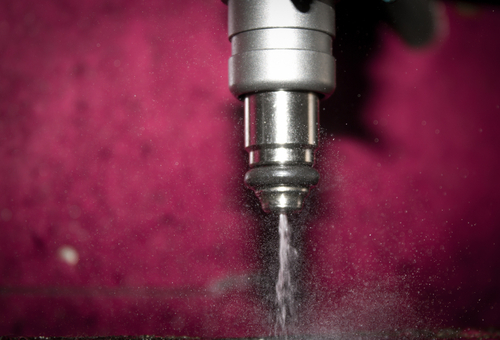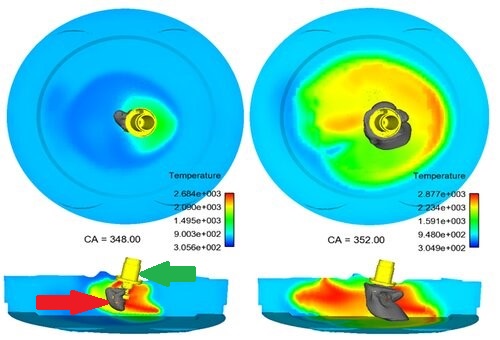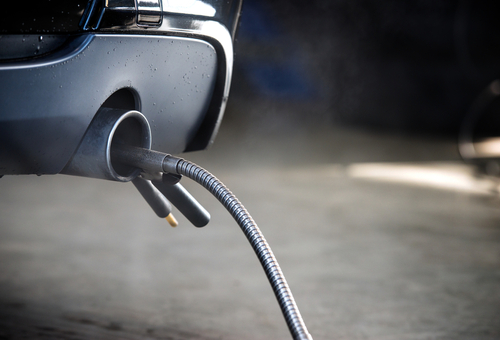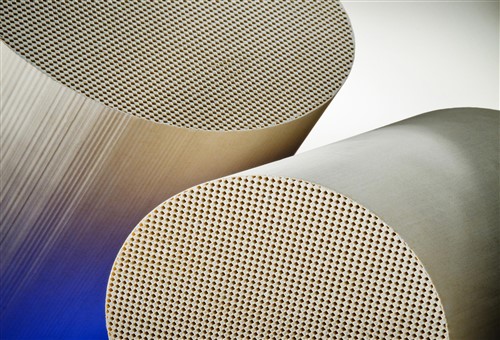
While it is true that engines with direct petrol injection produce more power and use less fuel per unit of displacement than comparable engines with port fuel injection, it is now becoming evident that the advantage of improved fuel economy and power comes with serious, albeit unintended consequences in terms of increased exhaust emissions. At first reading, this statement appears to be counter-intuitive, since using less fuel to produce more power should translate into fewer emissions but this is not the case, so in this article, we will take a closer look at the problems that come with direct petrol injection, as well as some possible solutions to these problems. Let us start with this question-
Port fuel injection technology, in which fuel is injected into the intake manifold behind the intake valve, was able to meet Euro 4 emissions regulations and equivalent regulations elsewhere, relatively easily. However, the introduction of Euro 5 emissions regulations and subsequent refinements in Euro 5 regulations made it progressively more difficult and costly to refine port injection technology to keep on meeting stricter emissions regulations.
Efforts to meet the stricter Euro 5 regulations included multiple injection events per cylinder, multi-spark delivery at low engine speeds, introducing turbulence in intake manifold runners to improve mixing of air and fuel, as well as using variable valve timing and valve lift systems. Despite these developments though, it remained almost impossible to-
Thus, given the limitations of port fuel injection, it became impossible to meet Euro 6 (and equivalent regulations in the USA, China, and Japan) when these were introduced by the European Union in 2014/2015. We need not rehash the Euro 5 standards here, but we do need to quote at least the basic Euro 6 requirements (in terms of solid particle emissions) here to understand what we as technicians will be required to fix soon-
“ In Europe, a 5 mg/km (3.1 mg/mi) PM emission limit for GDI engines took effect in 2009 with the Euro 5 standard. The first restrictions for particulate number (PN) emissions—considered more difficult to achieve than PM targets—come into effect this year with Euro 6. The latter initially limits PN totals to 6 × 1012 number/km, and then in late 2017 falls an order of magnitude to 6 × 1011number/km.” Source: https://www.sae.org/news/2014/10/attacking-gdi-engine-particulate-emissions
Note that while direct petrol injection also produces purely gaseous exhaust emissions, the most important and most harmful form of exhaust emission produced by this technology is solid particulate matter, which is why the Euro 6 standards set precise limits on the maximum allowable number of particles, i.e., 6 × 1011 particles per km after 2017. Note though that this number of solid particles exceed the maximum number of solid particles emitted by both diesel vehicles fitted with diesel particulate filters, and petrol engines with port fuel injection by between five and ten times.

Image source: https://www.sae.org/binaries/content/gallery/cm/articles/news/2014/10/13624_20963_act.png
NOTE: Before we get to some specifics of the problem with direct petrol injection and the Euro 6 emissions regulations, we need to explain what the above image represents. This image is a small section of a larger sequence of images that can be seen here, that shows the formation and growth of a cloud of soot in a cylinder, with the cloud of soot growing progressively larger and denser per degree of crankshaft rotation as the combustion event progresses. In this image, the red arrow indicates the initiation of the soot cloud, while the green arrow indicates the fuel injector.
Of course, this image begs the question of why soot would be forming in the cylinders of petrol engines, in the first place. Here is why and how it happens-
When it became clear that port injection technology could no longer meet the demands of progressively more stringent exhaust emissions regulations, engine designers hit on the idea of injecting petrol directly into the cylinders, on the assumption that this strategy would eliminate most, if not all of the limitations of port fuel injection.
Early computer models appeared to support this assumption, but as it turned out later, the early computer models did not take full account of the physics of the process. For instance, with port injection, the fuel droplets injected behind an intake valve are slowed down by the inrushing intake air, so they have plenty of time to mix with the air as they are sucked into the cylinder. While this did not produce perfectly homogenous air/fuel mixtures, the air molecules and fuel droplets all moved in the same direction and at about the same speed as they entered the cylinders, which largely prevented stratification of the air and fuel in the cylinders.
By way of contrast, and in practice, when petrol is injected directly into a cylinder, the time available for the fuel and air to mix is limited to the duration of both the injection event and the time the intake valve is open. Thus, since the intake air possesses mass, the inrushing air bounces off the top of the piston and cylinder walls because it has a high velocity, and therefore, the design of both the piston crown and combustion chamber are critically important to ensure efficient mixing of the fuel vapour and intake air, since mixing cannot occur in the intake manifold.
However, since the velocity of the intake air changes with engine speed, there is no single piston crown/combustion chamber design that ensures efficient mixing of the air and fuel under all operating conditions. Therefore, under some operating conditions, some fuel droplets can bounce off the piston crown and cylinder walls before they have time to mix with the inrushing air molecules.
Three things happen under these conditions. The first is that the air/fuel mixture becomes stratified when the compression pressure starts to build; the second is that the combustion flame propagates unevenly through the air/fuel mixture, and the third is that solid particulate matter (soot) forms in areas in the cylinder where the air/fuel mixture is not in a stoichiometric ratio.
It is with the third thing that both designers of direct petrol injection systems and regulatory authorities the world over have the most problems with, so let us look at-

According to research published by the European Commission in 2016, around 500 000 European citizens die premature deaths as the direct result of excessive air pollution. While the report points out that not all premature deaths can be blamed on pollution caused by direct petrol injection technology, the fact is that in 2016, about 66% of all new petrol engines in the European Union used direct petrol injection.
In the North American market, direct petrol injection is in use on an estimated 48.5% of all new petrol vehicles. Moreover, several recent studies suggest that by 2025, the number of cars with direct petrol injection will reach about 40 million globally, a significant percentage of which will eventually be in use on Australian roads, and particularly in densely populated metropolitan areas.
This last point is particularly important since the particles that are formed in direct petrol injection engines vary in size from 5 to 5000 nanometres, and consist of massive (heavy) hydrocarbons and tarry substances that do not evaporate as readily as particles that are formed in diesel and/or port fuel injection engines.
Worse, though, researchers at Oak Ridge National Laboratory’s (ORNL) Fuels, Engines, and Emissions Research Center in the USA have shown that particulates formed in direct petrol injection engines penetrate deeper into human lung tissue than particulates from diesel and port fuel injection engines, thus contributing to severe respiratory issues and cardiovascular disease in both adults and children. Additionally, solid particles derived from direct petrol injection also have severe irritating effects on the eyes, as well as on the mucous membranes in the noses and throats of most people, and particularly in people with existing respiratory ailments or conditions.
Based on the above, public health authorities the world over but particularly in the EU, China, and Japan, are growing increasingly concerned over the rising levels of invisible particulate matter in petrol exhaust. Therefore, public health authorities in these markets are among the main drivers behind processes to force car manufacturers to adopt new emissions testing methods that are based on real-world driving conditions, as opposed to tests that are performed in laboratories under simulated driving conditions.
As matters stand now, however, car manufacturers are fiercely opposed to the adoption of real-world exhaust emissions testing for reasons that we do not need to delve into here. However, we can do the next best thing, which is to look at some strategies car manufacturers are somewhat reluctantly implementing now, or are thinking of implementing to reduce particulate formation in direct petrol injection engines. Nonetheless, let us start by looking at-

Image source: https://www.sae.org/binaries/content/gallery/cm/articles/news/2014/10/13624_20961_act.jpg
In their simplest form, petrol particulate filters are derived from and are based on diesel particulate filters in the sense that particle-laden exhaust gas is forced to flow through a porous substrate that captures the particles. However, in the case of petrol particulate filters, the pores in the substrate can capture particles as small as one nanometre in diameter, but the single biggest difference between petrol and diesel petrol particulate filters involves the flow pattern of exhaust gas through the substrate.
In a diesel particulate filter, the channels in the substrate are open at both ends, thereby allowing the exhaust stream to flow freely through the channels in the substrate. In petrol particulate filters, however, the channels in the substrate are blocked at alternate ends, which forces exhaust gas to flow cross-wise through the walls between the channels, as opposed to through the open channels along the length of the substrate.
While manufacturers like Ford, Porsche, Kia, Mercedes, and BMW have shown that petrol particulate filters can remove over 90% of solid particles from petrol exhaust, the problem is that the tests were performed under real-world driving conditions with Euro 6 compliant fuel. As a matter of great interest, Euro 6 compliant fuel contains about 50 times less sulphur than Australian petrol, which sometimes struggles to meet Euro 5 quality standards, in a manner of speaking.
This is a very important point from our perspective as Australian technicians because fuel quality lays at the heart of both petrol particulate filter efficiency, and how well these filters can be regenerated. Current experimentation with the filter location has shown that if the filter is placed close to the exhaust manifold, the high temperature of the exhaust gas regenerates the filter substrate almost continuously, and therefore, petrol particulate filter regeneration is not subject to cyclical regeneration in the way that diesel particulate filters are. However, there is no telling how efficient petrol particulate filters will be with Australia’s Euro 5 petrol, or how the high sulphur content of Australian petrol will affect the regeneration process.
The most likely scenario is that petrol particulate filters on Australian vehicles will clog up relatively quickly, and/or will not regenerate fully, which will greatly add to the throttling effect an additional exhaust after-treatment component will have on an engine. As it is, there is no technical information available on how petrol particulate filters affect engine performance and fuel economy on vehicles in other markets where there are already significant numbers of vehicles with these devices in service.
Therefore, when vehicles fitted with petrol particulate filters start arriving in Australia in significant numbers, we will likely begin to see issues like severe increases in fuel consumption, vehicles with hard starting or no-start issues, and progressively increasing power losses as the particulate filters clog up. None of these issues seems to affect vehicles fitted with petrol particulate filters that run on Euro 6 fuel in other markets, but as we know, Australia does not have Euro 6 compliant fuel.
Nonetheless, many markets outside of the US, Europe, and Japan also do not have access to Euro 6 compliant fuel, which is the main argument that car manufacturers are using against the forced introduction of petrol particulate filters. Thus, almost all manufacturers that market direct petrol injection engines are proposing-
Although petrol particulate filters only add about 100 US dollars to the cost of new vehicles, car manufacturers are wary of warranty implications in markets where fuel does not meet Euro 6 standards, and therefore, all major car manufacturers are now investigating so-called "engine management" options to mitigate or reduce particle formation in direct petrol injection engines. Unfortunately, there is not a lot of technical information available on these possible solutions, but some proposed methods are said to include-
There may be other, proprietary methods currently under current, but if there are, no manufacturer is sharing them, or any details about them with the outside world, which leaves us with this-
Of course, there is a possibility that vehicles exported to markets such as Australia and Southern Africa (among others) may not be fitted with petrol particulate filters. However, this will be unlikely, given that car manufacturers in the USA, Europe, and Japan will be forced to apply to their governments to exempt a certain percentage of their production volumes from the legal requirement to fit particulate filters to all new petrol vehicles.
As a practical matter, and even if such exemptions were approved, policing such exemptions will be administrative, legal, and political nightmares for the governments involved, especially given the fact that almost all car manufacturers are already mounting a collective and fierce resistance against the introduction of exhaust emissions testing under real-world driving conditions.
Therefore, the best thing that we, as Australian technicians can hope for is that a) Australian petrol will not have an overly negative effect on the efficiency of petrol particulate filters, and hence, on engine performance, and b), that effective “engine management” methods to control particle formation in direct petrol injection engines are developed sooner, rather than later.